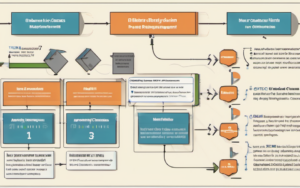Blockchain technology has gained immense popularity for its revolutionary potential to revolutionize various industries, from finance to supply chain management. At the heart of this transformative power lies the promise of blockchain security. The decentralized and immutable nature of blockchain has led many to believe that it offers an impenetrable fortress against threats. However, it’s crucial to approach this narrative with a balanced perspective, recognizing that while blockchain possesses inherent security advantages, it’s not without its vulnerabilities.
The Allure of Blockchain Security
The allure of blockchain security stems from its unique architecture, which fundamentally differs from traditional centralized systems.
Immutability and Transparency
Blockchain records transactions in a distributed ledger, creating a permanent and tamper-proof history. Once a transaction is added to the blockchain, it’s virtually impossible to alter or erase it, providing a high level of data integrity. This immutability is a significant advantage, as it enhances trust and accountability within the system. The transparency of the blockchain, where all transactions are visible and auditable by anyone, further reinforces this trust.
Decentralization and Resistance to Censorship
Unlike centralized systems where a single entity controls access and data, blockchain networks are decentralized, meaning no single point of failure exists. This decentralized nature makes it extremely difficult for malicious actors to manipulate or shut down the entire system. Additionally, the resistance to censorship inherent in blockchain technology empowers individuals to participate freely, without fear of arbitrary control.
Exploring the Cracks in the Armor
While blockchain offers significant security advantages, it’s essential to acknowledge that it’s not a foolproof solution. Several potential weaknesses can be exploited by malicious actors, highlighting the need for ongoing vigilance and proactive security measures.
Smart Contract Vulnerabilities
Smart contracts, the self-executing programs that govern transactions on the blockchain, are susceptible to vulnerabilities.
Code Errors and Exploits
Programming errors or flaws in smart contract code can create opportunities for attackers to exploit vulnerabilities and execute malicious actions. These vulnerabilities can range from simple logic errors to complex security loopholes, potentially leading to significant financial losses or data breaches.
Re-entrancy Attacks
Re-entrancy attacks exploit a vulnerability in the way some smart contracts handle multiple function calls. Attackers can manipulate the contract’s execution flow, causing it to re-enter a function before completing the initial call, allowing them to drain funds or manipulate the contract’s state.
Key Management and Private Key Security
The security of blockchain systems relies heavily on the secure management of private keys.
Phishing and Social Engineering
Attackers can use phishing scams and social engineering techniques to steal private keys from unsuspecting users. These attacks can involve fraudulent emails, websites, or other means of deception, targeting users with promises of rewards or threats of consequences.
Hardware and Software Vulnerabilities
Malicious actors can exploit vulnerabilities in hardware or software used to store and manage private keys. These vulnerabilities might exist in wallets, exchanges, or other tools that interact with the blockchain, potentially allowing attackers to gain unauthorized access to user funds.
51% Attacks and Network Consensus
A 51% attack occurs when a single entity or group gains control over more than 50% of the network’s computing power.
The Power of Majority Control
By controlling a majority of the network’s hash rate, attackers can potentially double-spend coins, manipulate transactions, or even alter the blockchain’s history. This threat highlights the importance of network decentralization and the need for diverse participation in the blockchain ecosystem.
Mitigating the Risk
While a 51% attack is technically feasible, it’s highly improbable in most well-established blockchains due to the significant resources required to achieve such dominance. Nevertheless, developers and users should be aware of this risk and prioritize security measures that mitigate its potential impact.
Beyond the Technical: Human Factors and Social Engineering
Beyond the technical vulnerabilities, human factors and social engineering play a critical role in blockchain security.
Social Engineering and Deception
Attackers often exploit human vulnerabilities through social engineering tactics.
Phishing and Impersonation
Phishing attacks are a common threat, where attackers impersonate legitimate entities to trick users into revealing sensitive information, such as private keys or login credentials. They may use email, social media, or other channels to lure users into malicious websites or download malware.
Exploiting Trust and Authority
Attackers can leverage trust and authority to gain access to sensitive information or systems. They might impersonate trusted individuals, organizations, or even government agencies to manipulate users into complying with their requests.
Regulatory Uncertainty and Legal Loopholes
The rapidly evolving nature of blockchain technology has led to regulatory uncertainty and legal loopholes, creating challenges for secure adoption.
Lack of Clear Regulations
The lack of clear regulatory frameworks in many jurisdictions can create a gray area for blockchain-based activities, making it difficult to establish consistent security standards and enforce compliance.
Jurisdictional Challenges
The decentralized nature of blockchain makes it difficult to establish clear jurisdictional boundaries for legal issues related to security breaches, fraud, or other criminal activities. This can pose challenges for law enforcement and regulatory bodies seeking to investigate and prosecute offenders.
Building a More Secure Future
Despite the challenges, the blockchain community is actively working to enhance security and mitigate vulnerabilities.
Continuous Auditing and Code Review
Regular security audits and code reviews are essential for identifying and addressing potential vulnerabilities in smart contracts and other blockchain systems. These audits should be conducted by independent experts with specialized knowledge in blockchain security.
Enhanced Security Practices and Education
Users need to be educated about the importance of secure key management, phishing prevention, and other security practices. This includes using secure wallets, enabling two-factor authentication, and being cautious about suspicious links and emails.
Collaboration and Community Engagement
Collaboration and community engagement are vital for fostering a secure blockchain ecosystem. Developers, researchers, and users need to work together to share best practices, identify vulnerabilities, and develop innovative solutions.
Conclusion: A Balanced Perspective on Blockchain Security
Blockchain technology holds immense promise for transforming industries and empowering individuals. However, it’s crucial to approach blockchain security with a balanced perspective, recognizing that while it offers significant advantages, it’s not immune to vulnerabilities. By understanding the potential weaknesses, implementing robust security measures, and fostering a culture of collaboration, we can build a more secure and trustworthy blockchain ecosystem for the future.




